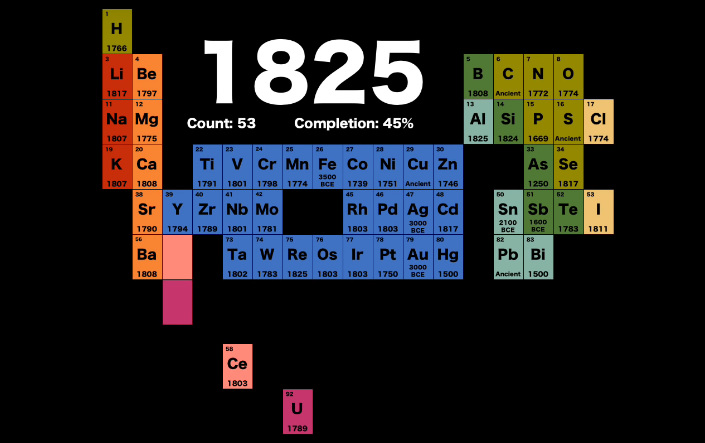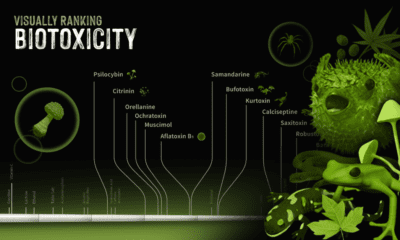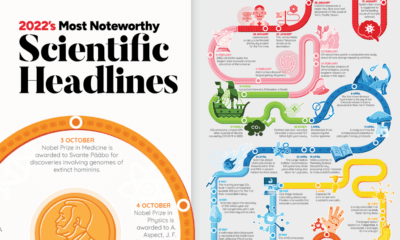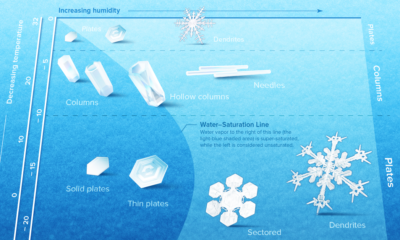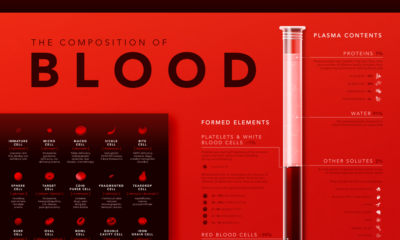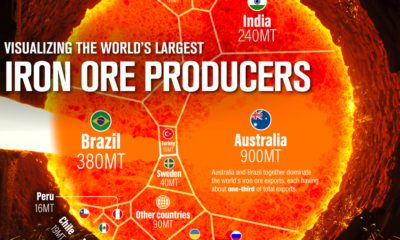Our fundamental understanding of the periodic table has allowed us to: build rockets that can withstand scorching temperatures; harness permanent magnets that can help us generate electricity; erect ultra strong and tall skyscrapers; and discover compounds that can eradicate disease around the world. But while we take this elemental knowledge for granted today, there was a time not too long ago when the periodic table was mostly empty.
The Elemental Dark Age
Today’s animation comes to us from materials scientist Dr. Jamie Gallagher and it chronicles the last three centuries of discoveries for the periodic table of elements. It starts in the year 1718, around time of Isaac Newton, when the scientific method was young and the knowledge we had around chemistry was still very incomplete.
At the time, we knew about elements like iron, copper, gold, silver, and lead – but the periodic table contained just 11% of elements compared to today.
A Flurry of New Discoveries
In the late 18th century and early 19th century, researchers started seeing patterns that allowed them to make new discoveries. Specifically, the years between 1788-1825 were particularly fruitful – over this stretch, the periodic table more than doubled in size from 26 to 53 elements.
Lithium, calcium, titanium, vanadium, tungsten, palladium, silicon, niobium, and uranium were some of the elements to join the table during this critical time period.
Formation of the Periodic Table
In the 19th century, the French geologist Alexandre-Emile Béguyer de Chancourtois was the first to notice the periodicity of elements, and in 1862 devised an early version of the periodic table. A few years later, in 1869, Russian chemist Dmitri Mendeleev created a table organized by atomic mass, which more closely resembles the one we use today. Here were the elements known at the time:
While nowhere near complete, it includes many of the elements that are used in modern life today.
The Final Touches
By the 20th century, chemistry was becoming more formalized, as we knew more about atoms, protons, electrons, neutrons, and so on. This led to the fleshing out of the periodic table as we know it. By this point, researchers were even creating radioactive, synthetic elements like unununium (Atomic number 111) which is now known as Roentgenium. Like many other late element discoveries, this one is not found in nature and the most common isotope has a half-life of just 100 seconds. These final discoveries, some of which happened in recent decades, helped bring up the periodic table to its current size: 118 elements. on Even while political regimes across these countries have changed over time, they’ve largely followed a few different types of governance. Today, every country can ultimately be classified into just nine broad forms of government systems. This map by Truman Du uses information from Wikipedia to map the government systems that rule the world today.
Countries By Type of Government
It’s important to note that this map charts government systems according to each country’s legal framework. Many countries have constitutions stating their de jure or legally recognized system of government, but their de facto or realized form of governance may be quite different. Here is a list of the stated government system of UN member states and observers as of January 2023: Let’s take a closer look at some of these systems.
Monarchies
Brought back into the spotlight after the death of Queen Elizabeth II of England in September 2022, this form of government has a single ruler. They carry titles from king and queen to sultan or emperor, and their government systems can be further divided into three modern types: constitutional, semi-constitutional, and absolute. A constitutional monarchy sees the monarch act as head of state within the parameters of a constitution, giving them little to no real power. For example, King Charles III is the head of 15 Commonwealth nations including Canada and Australia. However, each has their own head of government. On the other hand, a semi-constitutional monarchy lets the monarch or ruling royal family retain substantial political powers, as is the case in Jordan and Morocco. However, their monarchs still rule the country according to a democratic constitution and in concert with other institutions. Finally, an absolute monarchy is most like the monarchies of old, where the ruler has full power over governance, with modern examples including Saudi Arabia and Vatican City.
Republics
Unlike monarchies, the people hold the power in a republic government system, directly electing representatives to form government. Again, there are multiple types of modern republic governments: presidential, semi-presidential, and parliamentary. The presidential republic could be considered a direct progression from monarchies. This system has a strong and independent chief executive with extensive powers when it comes to domestic affairs and foreign policy. An example of this is the United States, where the President is both the head of state and the head of government. In a semi-presidential republic, the president is the head of state and has some executive powers that are independent of the legislature. However, the prime minister (or chancellor or equivalent title) is the head of government, responsible to the legislature along with the cabinet. Russia is a classic example of this type of government. The last type of republic system is parliamentary. In this system, the president is a figurehead, while the head of government holds real power and is validated by and accountable to the parliament. This type of system can be seen in Germany, Italy, and India and is akin to constitutional monarchies. It’s also important to point out that some parliamentary republic systems operate slightly differently. For example in South Africa, the president is both the head of state and government, but is elected directly by the legislature. This leaves them (and their ministries) potentially subject to parliamentary confidence.
One-Party State
Many of the systems above involve multiple political parties vying to rule and govern their respective countries. In a one-party state, also called a single-party state or single-party system, only one political party has the right to form government. All other political parties are either outlawed or only allowed limited participation in elections. In this system, a country’s head of state and head of government can be executive or ceremonial but political power is constitutionally linked to a single political movement. China is the most well-known example of this government system, with the General Secretary of the Communist Party of China ruling as the de facto leader since 1989.
Provisional
The final form of government is a provisional government formed as an interim or transitional government. In this system, an emergency governmental body is created to manage political transitions after the collapse of a government, or when a new state is formed. Often these evolve into fully constitutionalized systems, but sometimes they hold power for longer than expected. Some examples of countries that are considered provisional include Libya, Burkina Faso, and Chad.

